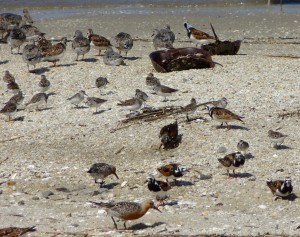May 13, 2016
I am standing high on the shore, above one of Cape May’s beaches, watching a banner of birds swoop in across the waters of the Delaware Bay, land on the sand, and immediately begin to probe the sands for the eggs of the horseshoe crabs. These small birds are red knots, members of the sandpiper family. They have flown from their wintering grounds in harsh Tiera del Fuego at the tip of South America, with a brief stopover in Brazil, and then nonstop for two days to the Delaware Bay. I am filled with awe and amazement for these pretty little birds. Somehow they time their arrival at the Delaware Bay for the high tide and full moon of May, when the horseshoe crabs come out of the ocean and drag themselves above the high tide mark to lay their eggs. The birds must double their weight in about ten days time, before continuing their journey north to the Canadian Arctic, where they will breed. It is a migration of over 8,000 miles. And until today, I never knew about these birds.
Due to the harvest of horseshoe crabs for bait, their numbers have plummeted and so have the numbers of red knots, almost to the point of extinction. A moratorium on the harvesting of the crabs has helped stop the drop in numbers of both species, and there is some hope. Dedicated scientists from Australia, New Zealand, and the US track the little birds, from the tip of South America to the barren Arctic lands in Canada. In Delaware, beaches are roped off to safeguard the horseshoe crabs and the birds, and volunteers monitor the beaches.
Above the roped off beach, I watch the red knots in their mating plumage plunge their beaks into the sand (foreground.) Ruddy turnstones dig holes in the sand, looking for eggs, and herring gulls and laughing gulls probe at the insides of unfortunate horseshoe crabs who lie upside down on the beach, unable to right themselves. I wish I could help the crabs, but no one can go onto the beach and disturb the birds. At night volunteers turn over any crabs that need help. The beach is filled with the cries of birds and constant motion. And I am filled with a sense of wonder at the mystery of life.

Leave a Reply